Effect of Attitudinal, Situational and Demographic Factors on Annoyance Due to Environmental Vibration and Noise from Construction of a Light Rapid Transit System
Abstract
:1. Introduction
2. Methodology
2.1. Study Design
2.2. Vibration Exposure
2.3. Noise Exposure
- sound power outputs of the processes and plant;
- periods of operation of the processes and plant;
- distance from sources and receivers;
- presence of shielding, screening and barriers;
- reflection of sound;
- soft ground attenuation;
- meteorological factors, if the distance between the source and receiver is greater than or equal to 50 m.
2.4. Locations and Respondents
2.5. Questionnaire
3. Statistical Analyses
4. Results
4.1. Noise Exposure-Annoyance
4.2. Vibration Exposure-Annoyance
4.3. Self-Reported Sensitivity to Vibration
4.4. Concern for Property Damage
4.5. Expectation
4.6. Ownership
4.7. Visibility of the Construction Site
4.8. Time Spent at Home
4.9. Neighbourhood/Home Satisfaction
4.10. Age
4.11. Gender
5. Discussion
5.1. Non-Exposure Factors
5.1.1. Self-Reported Sensitivity to Vibration
5.1.2. Expectation
5.1.3. Concern about Property Damage
5.1.4. Tenure Type (Ownership)
5.1.5. Visibility
5.1.6. Age
5.1.7. Gender
5.1.8. Home/Neighbourhood Satisfaction
5.2. Noise Exposure
- A weekly continuous monitoring of all construction work stages for longer periods of time;
- Recording of sound during monitoring so that sources could be identified and easily recognised;
- Possibility of setting a measurement instrument within the vicinity of a source or installing a number of instruments, such that a construction process will occur within close proximity of at least one.
5.3. Implications
6. Conclusions
Acknowledgments
Author Contributions
Conflicts of Interest
Appendix A. A Questionnaire
| Question | Responses | Frequency | % | Total/350 | Recoding/Routing |
|---|---|---|---|---|---|
| A1. In which of the following is the property situated? | Centre of a large city | 0 | 0.0 | 336 | |
| Suburbs/Outskirts of a large city | 257 | 73.4 | |||
| Large town or small city | 76 | 21.7 | |||
| Small town | 3 | 0.9 | |||
| Village | 0 | 0.0 | |||
| Countryside | 0 | 0.0 | |||
| Other | 0 | 0.0 | |||
| Missing | 14 | 4.0 | |||
| B4. Looking at this card [show card 1], overall, how satisfied or dissatisfied are you personally with living in this neighbourhood? Would you say that you are very satisfied, satisfied, neither satisfied nor dissatisfied, dissatisfied or very dissatisfied? | Very satisfied | 112 | 32.0 | 350 | |
| Satisfied | 160 | 45.7 | |||
| Neither satisfied nor dissatisfied | 25 | 7.1 | |||
| Dissatisfied | 27 | 7.7 | |||
| Very dissatisfied | 26 | 7.4 | |||
| Missing | 0 | 0.0 | |||
| C2. Looking at this card [show card 1], overall, how satisfied or dissatisfied are you personally with living in this home? Would you say that you are very satisfied, satisfied, neither satisfied nor dissatisfied, dissatisfied or very dissatisfied? | Very satisfied | 138 | 39.4 | 350 | |
| Satisfied | 163 | 46.6 | |||
| Neither satisfied nor dissatisfied | 21 | 6.0 | |||
| Dissatisfied | 16 | 4.6 | |||
| Very dissatisfied | 12 | 3.4 | |||
| Missing | 0 | 0.0 | |||
| C9. Looking at this list [show card 3], which best describes your current situation with this home? Do you or your family: | Own outright or with a mortgage | 228 | 65.1 | 348 | Responses to this questions were recoded as to whether they had some stake in the property or not, i.e., A: (Own/Mortgage/Part mortgage), B: (Private Rent/Association Rent). |
| Part-rent and part-own with a mortgage | 9 | 2.6 | |||
| Rent from a private landlord/letting agency | 53 | 15.1 | |||
| Rent from a Housing Association or Council | 53 | 15.1 | |||
| Other | 5 | 1.4 | |||
| Missing | 2 | 0.6 | |||
| C12. From any room in this home, can you see: Construction Activity | No | 202 | 57.7 | 345 | |
| Yes | 143 | 40.9 | |||
| Missing | 5 | 1.4 |
| Question | Responses | Frequency | % | Total/350 | Recoding/Routing |
|---|---|---|---|---|---|
| D1. Thinking about the time you have been living here, when indoors at home, have you felt any vibration or shaking anywhere that you think was caused by: | Cars, lorries, buses and other road vehicles | N: 229, Y: 120 | N: 65.4, Y: 34.4 | 349 | If respondents answered yes to any of these they were directed to further questions (D2–D4) about the vibration they felt: How, Where, Activity disturbed. Else they moved to questions about rattle. |
| Aeroplanes | N: 343, Y: 7 | N: 98.0, Y: 2.0 | 350 | ||
| Helicopters | N: 340, Y: 38 | N: 97.1, Y: 2.9 | 350 | ||
| Railway activity | N: 311, Y: 38 | N: 88.9, Y: 10.9 | 349 | ||
| Underground trains like the tube or metro | N: 343, Y: 6 | N: 98.0, Y: 1.7 | 349 | ||
| Trains in tunnels | N: 345, Y: 6 | N: 98.0, Y: 1.7 | 349 | ||
| Construction activity, including demolition, piling, road works, drilling, surface activity such as bulldozers and loading trucks and any other construction activity | N: 115, Y: 235 | N: 32.9, Y: 67.1 | 350 | ||
| Quarrying or mining | N: 348, Y: 2 | N: 99.4, Y: 0.6 | 350 | ||
| Footsteps, slamming doors, domestic appliances inside this home | N: 330, Y: 20 | N: 94.3, Y: 5.7 | 350 | ||
| Footsteps, slamming doors, domestic appliances in neighbouring homes | N: 338, Y: 12 | N: 96.6, Y: 3.4 | 350 | ||
| An unidentified source | N: 349, Y: 1 | N: 99.7, Y: 0.3 | 350 | ||
| Any other source | N: 336, Y: 14 | N: 96.0, Y: 4.0 | 350 | ||
| Summary, Felt vibration at all | N: 93, Y: 256 | N: 26.6, Y: 73.3 | 349 | ||
| D5. Thinking about the time you have been living here, when indoors at home, have you heard or seen things rattle, vibrate or shake that you think was caused by: | Cars, lorries, buses and other road vehicles | N: 286, Y: 55 | N: 81.7, Y: 15.7 | 341 | If respondents answered yes to any of these they were directed to further questions (D6–D8) about the rattle they felt: How, Where, Activity disturbed. |
| Aeroplanes | N: 340, Y: 1 | N: 97.1, Y: 0.3 | 341 | ||
| Helicopters | N: 337, Y: 4 | N: 96.3, Y: 1.1 | 341 | ||
| Railway activity | N: 319, Y: 22 | N: 91.1, Y: 6.3 | 341 | ||
| Underground trains like the tube or metro | N: 338, Y: 3 | N: 96.6, Y: 0.9 | 341 | ||
| Trains in tunnels | N: 340, Y: 1 | N: 99.7, Y: 0.3 | 341 | ||
| Construction activity, including demolition, piling, road works, drilling, surface activity such as bulldozers and loading trucks and any other construction activity | N: 182, Y: 159 | N: 53.4, Y: 46.6 | 341 | ||
| Quarrying or mining | N: 340, Y: 1 | N: 99.7, Y: 0.3 | 341 | ||
| Footsteps, slamming doors, domestic | N: 335, Y: 6 | N: 95.7, Y: 1.7 | 341 | ||
| appliances inside this home | |||||
| Footsteps, slamming doors, domestic appliances in neighbouring homes | N: 335, Y: 6 | N: 95.7, Y: 1.7 | 341 | ||
| An unidentified source | N: 341, Y: 0 | N: 100 | 341 | ||
| Any other source | N: 336, Y: 5 | N: 96.0, Y: 1.4 | 341 | ||
| Summary, Saw rattle at all | N: 167, Y: 174 | N: 49.0, Y: 51.0 | 341 | ||
| Summary of Vibration and Rattle | Felt or saw either vibration or rattle at all | N: 84, Y: 266 | N: 24.0, Y:76.0 | 350 |
| Question | Responses | Frequency | % | Total/350 | Recoding/Routing |
|---|---|---|---|---|---|
| D9. Thinking about the time you have been living here, when indoors at home, how bothered, annoyed or disturbed have you been by feeling vibration or shaking or hearing or seeing things rattle, vibrate or shake caused by construction activity? | don’t feel | 120.0 | 34.3 | 350 | Respondents were asked about their annoyance for the vibration sources they had noticed. If respondents previously stated they did not notice the vibration they were classed as don’t feel and then later recoded as not at all. |
| not at all | 66.0 | 18.9 | |||
| slightly | 32.0 | 9.1 | |||
| moderately | 38.0 | 10.9 | |||
| very | 31.0 | 8.9 | |||
| extremely | 63.0 | 18 | |||
| D11. In the future, do you think the level of vibration you experience whilst indoors at home will get worse, get better or remain the same? | Worse | 71 | 20.3 | 273 | Responses to this question were later recoded into two groups: A (Worse and Don’t Know) and B (Same and Better). Only those reporting noticing vibration or rattle were asked this question. |
| Better | 81 | 23.1 | |||
| Same | 43 | 12.3 | |||
| Don’t Know | 78 | 22.3 | |||
| Missing | 77 | 22.0 | |||
| D13. We would like to know if you are concerned that the vibration may damage this home or your possessions inside it in any way. | not at all | 181 | 51.7 | 350 | Only those reporting noticing vibration or rattle were asked this question. If respondents previously stated they did not notice vibration nor rattling they were re-classed as not at all. |
| slightly | 43 | 12.3 | |||
| moderately | 41 | 11.7 | |||
| very | 39 | 11.1 | |||
| extremely | 46 | 13.1 | |||
| Missing | 0 | 0.0 | |||
| D15. How sensitive would you say you are personally to vibration in general? Would you say you are not at all sensitive, slightly sensitive, moderately sensitive, very sensitive or extremely sensitive? | not at all | 98 | 28.0 | 273 | If respondents previously stated that they did not notice vibration nor rattling they were not asked this questions and were re-coded as not at all. |
| slightly | 78 | 22.3 | |||
| moderately | 51 | 14.6 | |||
| very | 27 | 7.7 | |||
| extremely | 19 | 5.4 | |||
| Missing | 77 | 22.0 | |||
| Y1. During a typical weekday, that is, Monday to Friday, what times are you usually at home? Are you at home between: | 06:01 and 09:00 | 301 | 86.0 | 330 | |
| 09:01 and 12:00 | 240 | 68.6 | |||
| 12:01 and 15:00 | 234 | 66.9 | |||
| 15:01 and 18:00 | 249 | 71.1 | |||
| 18:01 and 21:00 | 307 | 87.7 | |||
| 21:01 and 00:00 | 316 | 90.3 | |||
| 00:01 and 03:00 | 321 | 91.7 | |||
| 03:01 and 06:00 | 322 | 92.0 | |||
| Missing | 20 | 5.7 | |||
| Y2. During a typical weekend, that is, Saturday and Sunday, what times are you usually at home? Are you at home between: | 06:01 and 09:00 | 321 | 91.7 | 330 | |
| 09:01 and 12:00 | 301 | 86.0 | |||
| 12:01 and 15:00 | 288 | 82.3 | |||
| 15:01 and 18:00 | 293 | 83.7 | |||
| 18:01 and 21:00 | 305 | 87.1 | |||
| 21:01 and 00:00 | 311 | 88.9 | |||
| 00:01 and 03:00 | 315 | 90.0 | |||
| 03:01 and 06:00 | 320 | 91.4 | |||
| Missing | 19 | 5.4 |
References
- Waddington, D.C.; Woodcock, J.; Peris, E.; Condie, J.; Sica, G.; Moorhouse, A.T.; Steele, A. Human response to vibration in residential environments. J. Acoust. Soc. Am. 2014, 135, 182–193. [Google Scholar] [CrossRef] [PubMed]
- Sharp, C.; Woodcock, J.; Sica, G.; Peris, E.; Moorhouse, A.T.; Waddington, D.C. Exposure-response relationships for annoyance due to freight and passenger railway vibration exposure in residential environments. J. Acoust. Soc. Am. 2014, 135, 205–212. [Google Scholar] [CrossRef] [PubMed]
- Klæboe, R.; Fyhri, A. People’s Reactions to Vibrations in Dwellings from Road and Rail (Summary in English); Institute of Transport Economic: Oslo, Norway, 1999. [Google Scholar]
- Zapfe, J.A.; Saurenman, H.; Fidell, S. Ground-Borne Noise and Vibration in Buildings Caused by Rail Transit; Technical Report; Transport Research Board of the National Academies: Washington, DC, USA, 2009. [Google Scholar]
- Woodcock, J.; Peris, E.; Condie, J.; Sica, G.; Koziel, Z.; Evans, T.; Moorhouse, A.; Steele, A.; Waddington, D. Human response to vibration in residential environments (NANR209). In Technical Report 6: Determination of Exposure–Response Relationships; Defra: London, UK, 2011. [Google Scholar]
- Peris, E.; Woodcock, J.; Sica, G.; Sharp, C.; Moorhouse, A.T.; Waddington, D.C. Effect of situational, attitudinal and demographic factors on railway vibration annoyance in residential areas. J. Acoust. Soc. Am. 2014, 135, 194–204. [Google Scholar] [CrossRef] [PubMed]
- Wong-McSweeney, D.; Woodcock, J.; Peris, E.; Waddington, D.; Moorhouse, A.; Redel-Macis, M. Human Annoyance, Acceptability and Concern as Responses to Vibration from the Construction of Light Rapid Transit Lines in Residential Environments. Sci. Total Environ. 2016, in press. [Google Scholar] [CrossRef] [PubMed]
- Bradley, J.; Jonah, B. The effects of site selected variables on human responses to traffic noise, Part I: Type of housing by traffic noise level. J. Sound Vib. 1979, 66, 589–604. [Google Scholar] [CrossRef]
- Job, R. Community response to noise: A review of factors influencing the relationship between noise exposure and reaction. J. Acoust. Soc. Am. 1988, 83, 991–1001. [Google Scholar] [CrossRef]
- Fields, J.M. Effect of personal and situational variables on noise annoyance in residential areas. J. Acoust. Soc. Am. 1993, 93, 2753–2763. [Google Scholar] [CrossRef]
- Paunović, K.; Jakovljević, B.; Belojević, G. Predictors of noise annoyance in noisy and quiet urban streets. Sci. Total Environ. 2009, 407, 3707–3711. [Google Scholar] [CrossRef] [PubMed]
- Lercher, P.; Kofler, W. Behavioral and health responses associated with road traffic noise exposure along alpine through-traffic routes. Sci. Total Environ. 1996, 189, 85–89. [Google Scholar] [CrossRef]
- Miedema, H.M.; Vos, H. Demographic and attitudinal factors that modify annoyance from transportation noise. J. Acoust. Soc. Am. 1999, 105, 3336–3344. [Google Scholar] [CrossRef]
- Guski, R.; Felscher-Suhr, U.; Schuemer, R. The Concept of Noise Annoyance: How International Experts See It. J. Sound Vib. 1999, 223, 513–527. [Google Scholar] [CrossRef]
- Van Kamp, I.; Job, R.S.; Hatfield, J.; Haines, M.; Stellato, R.K.; Stansfeld, S.A. The role of noise sensitivity in the noise–response relation: A comparison of three international airport studies. J. Acoust. Soc. Am. 2004, 116, 3471–3479. [Google Scholar] [CrossRef] [PubMed]
- Heinonen-Guzejev, M. Noise Sensitivity Medical, Psychological and Genetic Aspects. Ph.D. Thesis, University of Helsinki, Helsinki, Finland, 2009. [Google Scholar]
- Guski, R. Personal and social variables as co-determinants of noise annoyance. Noise Health 1999, 1, 45. [Google Scholar] [PubMed]
- Guski, R. How to forecast community annoyance in planning noisy facilities. Noise Health 2004, 6, 59. [Google Scholar] [PubMed]
- Hatfield, J.; Job, R. Evidence of optimism bias regarding the health effects of exposure to noise. In Proceedings of the Noise Effects 1998 7th International Congress on Noise as a Public Health Problem, Sydney, Australia, 22–26 November 1998; pp. 251–254.
- Brown, A.; van Kamp, I. Response to a change in transport noise exposure: Competing explanations of change effects. J. Acoust. Soc. Am. 2009, 125, 905–914. [Google Scholar] [CrossRef] [PubMed]
- Langdon, F. Noise nuisance caused by road traffic in residential areas: Part I. J. Sound Vib. 1976, 47, 243–263. [Google Scholar] [CrossRef]
- Fields, J.M.; Walker, J. The response to railway noise in residential areas in Great Britain. J. Sound Vib. 1982, 85, 177–255. [Google Scholar] [CrossRef]
- Nelson, P.M. Transportation Noise Reference Book; Butterworth-Heinemann Ltd.: Oxford, UK, 1987. [Google Scholar]
- Klæboe, R.; Kolbenstvedt, M.; Lercher, P.; Solberg, S. Changes in noise reactions-Evidence for an area-effect? In Proceedings of INTER-NOISE and NOISE-CON Congress and Conference; Institute of Noise Control Engineering: Reston, VA, USA, 1998; Volume 1998, pp. 896–899. [Google Scholar]
- Bradley, J.; Jonah, B. The effects of site selected variables on human responses to traffic noise, part III: Community size by socio-economic status by traffic noise level. J. Sound Vib. 1979, 67, 409–423. [Google Scholar] [CrossRef]
- Fields, J.M. Reactions to environmental noise in an ambient noise context in residential areas. J. Acoust. Soc. Am. 1998, 104, 2245–2260. [Google Scholar] [CrossRef]
- Klæboe, R.; Kolbenstvedt, M.; Fyhri, A.; Solberg, S. The impact of an adverse neighbourhood soundscape on road traffic noise annoyance. Acta Acust. United Acust. 2005, 91, 1039–1050. [Google Scholar]
- Klæboe, R.; Engelien, E.; Steinnes, M. Context sensitive noise impact mapping. Appl. Acoust. 2006, 67, 620–642. [Google Scholar] [CrossRef]
- Bangjun, Z.; Lili, S.; Guoqing, D. The influence of the visibility of the source on the subjective annoyance due to its noise. Appl. Acoust. 2003, 64, 1205–1215. [Google Scholar] [CrossRef]
- Pedersen, E.; Larsman, P. The impact of visual factors on noise annoyance among people living in the vicinity of wind turbines. J. Environ. Psychol. 2008, 28, 379–389. [Google Scholar] [CrossRef]
- Nivison, M.E.; Endresen, I.M. An analysis of relationships among environmental noise, annoyance and sensitivity to noise, and the consequences for health and sleep. J. Behav. Med. 1993, 16, 257–276. [Google Scholar] [CrossRef] [PubMed]
- Van Gerven, P.W.; Vos, H.; Van Boxtel, M.P.; Janssen, S.A.; Miedema, H.M. Annoyance from environmental noise across the lifespan. J. Acoust. Soc. Am. 2009, 126, 187–194. [Google Scholar] [CrossRef] [PubMed]
- Öhrström, E.; Skånberg, A.B. A field survey on effects of exposure to noise and vibration from railway traffic, part I: Annoyance and activity disturbance effects. J. Sound Vib. 1996, 193, 39–47. [Google Scholar] [CrossRef]
- Yonekawa, Y. Evaluation of bullet train vibration for residents near railways. Ind. Health 1977, 15, 23–32. [Google Scholar] [CrossRef]
- Howarth, H.V.C. Annoyance caused by Railway Vibration and Noise in Buildings. Ph.D. Thesis, University of Southampton, Southampton, UK, 1989. [Google Scholar]
- Schomer, P.D.; Neathammer, R.D. The role of helicopter noise-induced vibration and rattle in human response. J. Acoust. Soc. Am. 1987, 81, 966–976. [Google Scholar] [CrossRef]
- Woodroof, H.; Griffin, M.J. Survey of the Effect of Railway-Induced Building Vibration on the Community; Technical Report; ISVR: Southampton, UK, 1987. [Google Scholar]
- Gidlöf-Gunnarsson, A.; Ögren, M.; Jerson, T.; Öhrström, E. Railway noise annoyance and the importance of number of trains, ground vibration, and building situational factors. Noise Health 2012, 14, 190–201. [Google Scholar] [CrossRef] [PubMed]
- Klæboe, R.; Turunen-Rise, I.; Hårvik, L.; Madshus, C. Vibration in dwellings from road and rail traffic—Part II: Exposure–effect relationships based on ordinal logit and logistic regression models. Appl. Acoust. 2003, 64, 89–109. [Google Scholar] [CrossRef]
- Fields, J.M. Railway noise and vibration annoyance in residential areas. J. Sound Vib. 1979, 66, 445–458. [Google Scholar] [CrossRef]
- Sica, G.; Peris, E.; Woodcock, J.; Moorhouse, A.; Waddington, D. Design of measurement methodology for the evaluation of human exposure to vibration in residential environments. Sci. Total Environ. 2014, 482, 461–471. [Google Scholar] [CrossRef] [PubMed]
- Woods, R.D. Dynamic Effects of Pile Installations on Adjacent Structures; Transportation Research Board, National Academy Press: Washington, DC, USA, 1997; Volume 253. [Google Scholar]
- Koziel, Z.; Peris, E.; Woodcock, J.; Sica, G.; Moorhouse, A.T.; Waddington, D.C. Calculation of noise in residential environments. In Proceedings of the 10th International Congress on Noise as a Public Health Problem (ICBEN), London, UK, 24–28 July 2011.
- Whittle, N.; Peris, E.; Condie, J.; Woodcock, J.; Brown, P.; Moorhouse, A.T.; Waddington, D.C.; Steele, A. Development of a social survey for the study of vibration annoyance in residential environments: Good practice guidance. Appl. Acoust. 2015, 87, 83–93. [Google Scholar] [CrossRef]
- Baron, R.M.; Kenny, D.A. The moderator–mediator variable distinction in social psychological research: Conceptual, strategic, and statistical considerations. J. Personal. Soc. Psychol. 1986, 51, 1173. [Google Scholar] [CrossRef]
- Field, A. Discovering Statistics Using IBM SPSS Statistics: And Sex, Drugs and Rock ”n” Roll, 4th ed.; Introducing Statistical Methods Series; SAGE Publications: London, UK, 2013. [Google Scholar]
- Peris, E. Human Response to Railway Vibration in Residential Environments: Exposure-Response Relationships and Modifying Factors. Ph.D. Thesis, Acoustics Research Centre, University of Salford, Greater Manchester, UK, 2012. [Google Scholar]
- Woodcock, J.; Sica, G.; Peris, E.; Sharp, C.; Moorhouse, A.; Waddington, D. Quantification of the effects of audible rattle and source type on the human response to environmental vibration. J. Acoust. Soc. Am. 2016, 139, 1225–1234. [Google Scholar] [CrossRef] [PubMed]
- Fernández, M.D.; Quintana, S.; Ballesteros, J.A.; González, I.; Vitón, B.; Díaz, C. Noise, Vibration and Perception of Risks of Workers of the Construction Sector. Acta Acust. United Acust. 2010, 96, 784–790. [Google Scholar] [CrossRef]

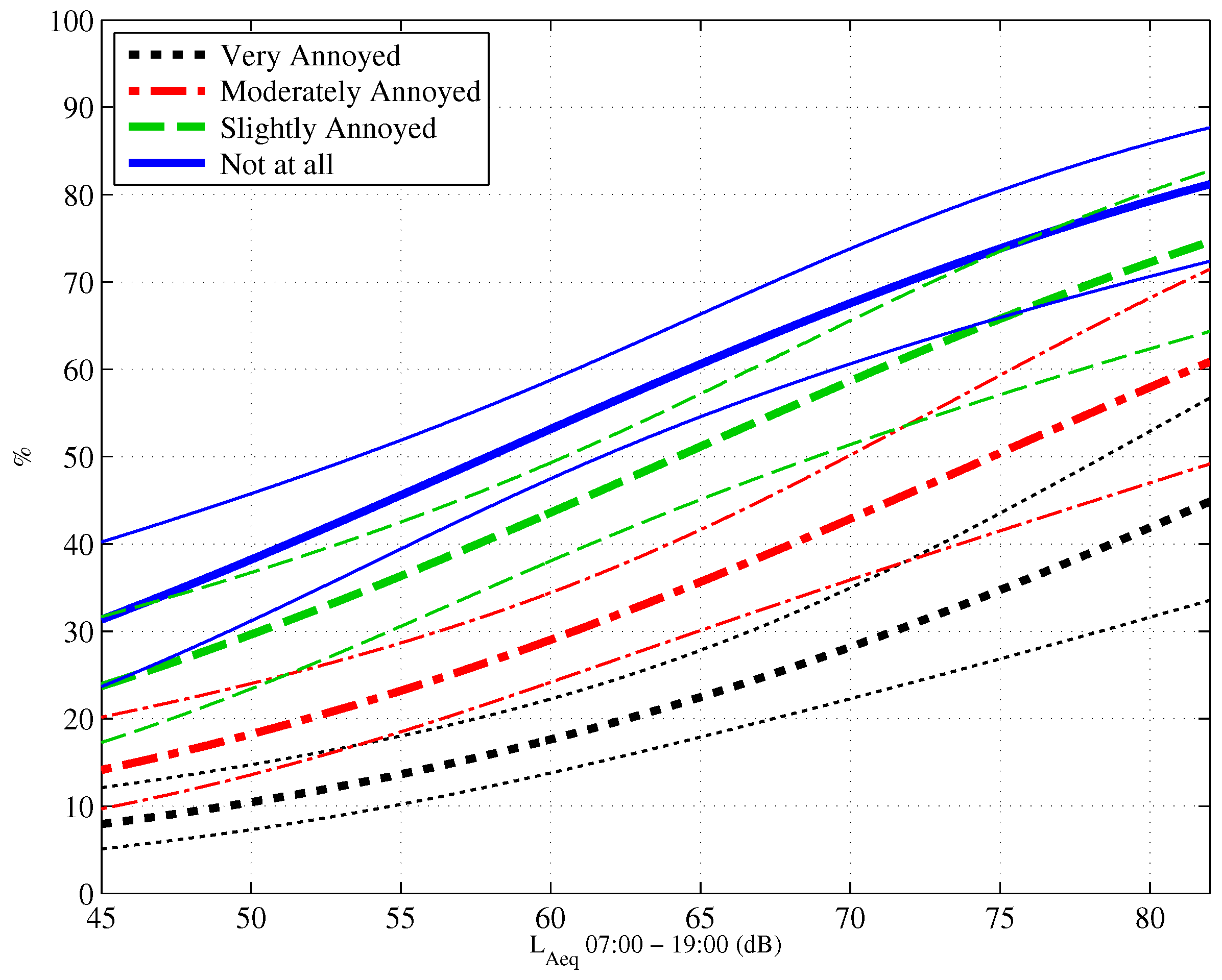

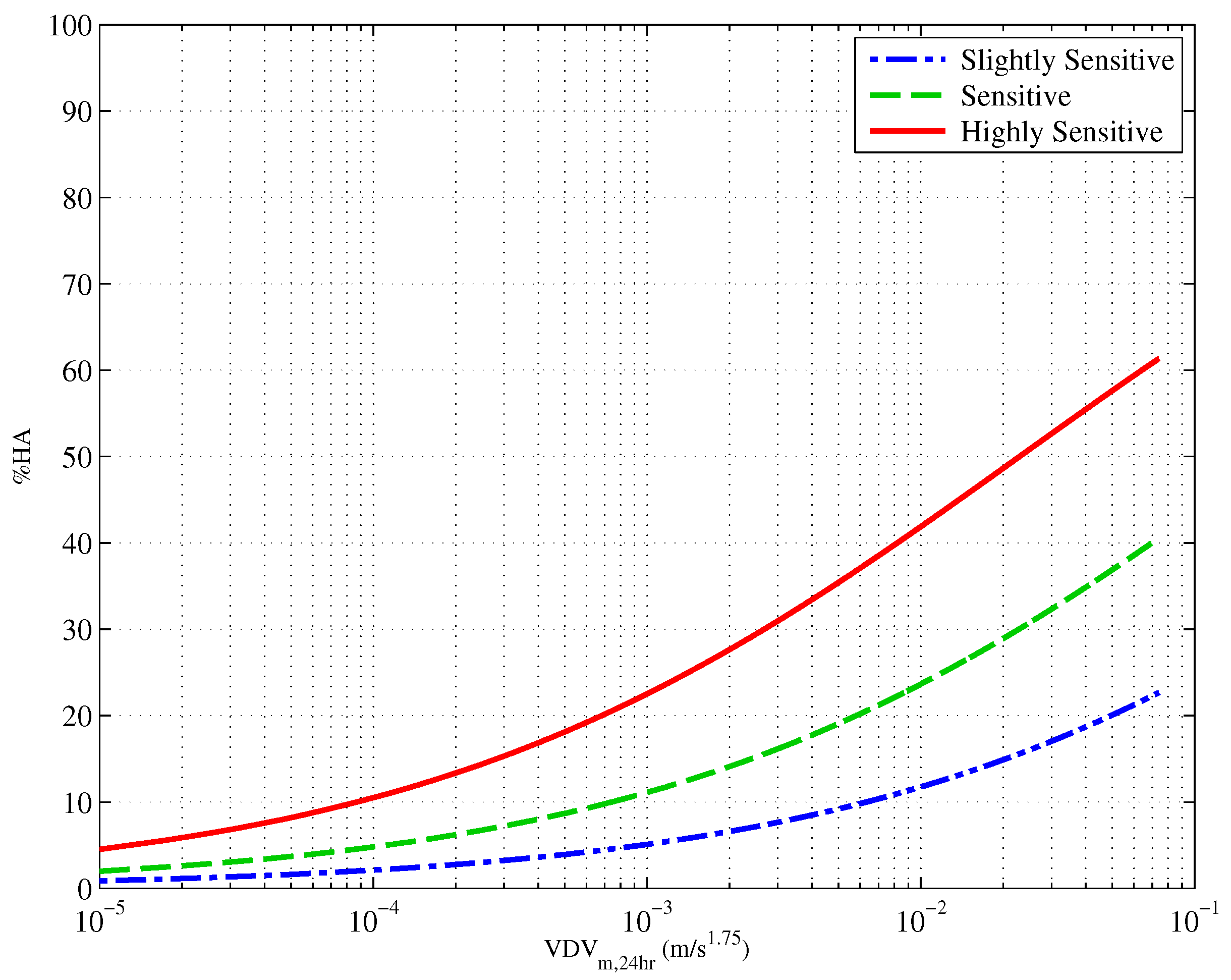
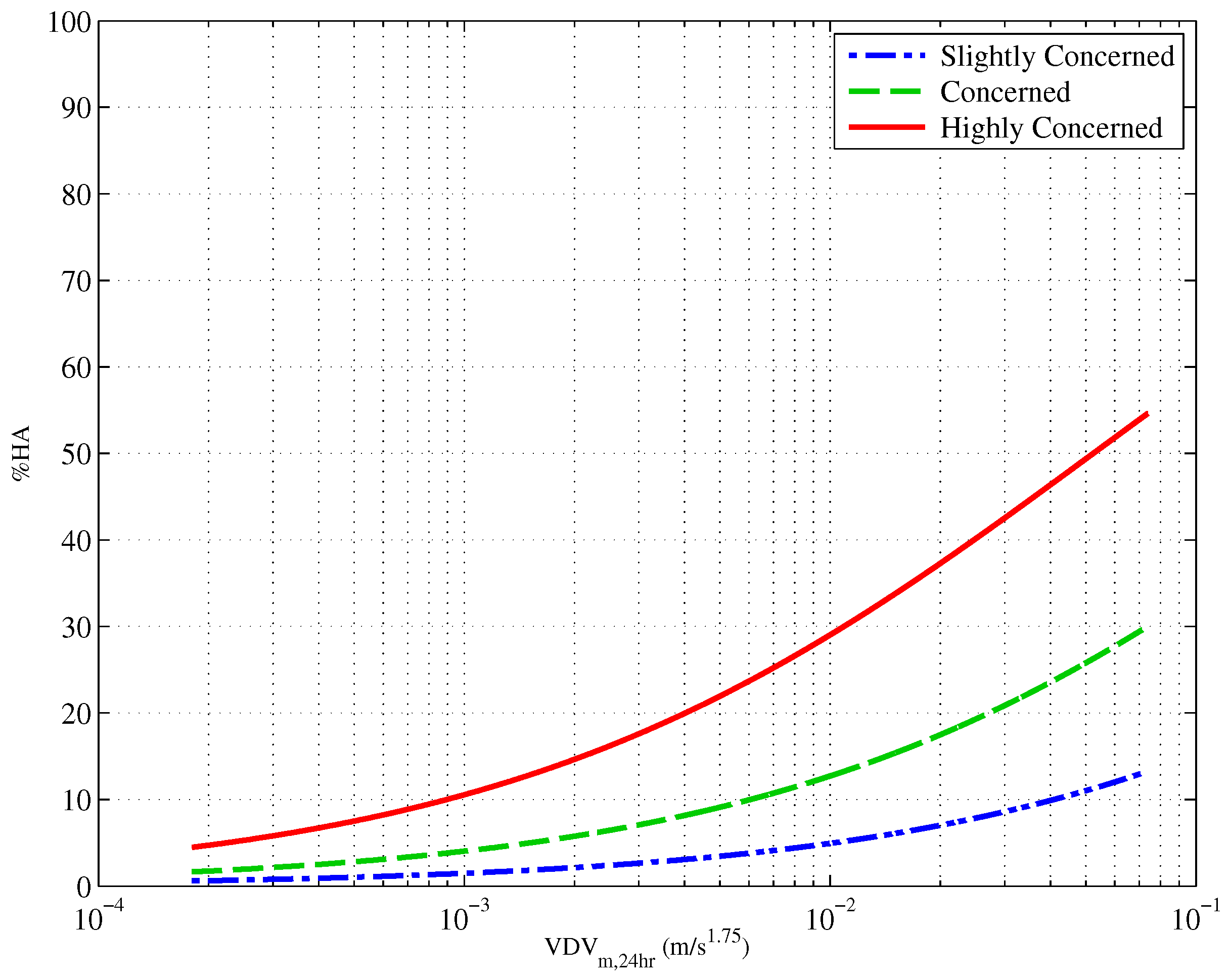


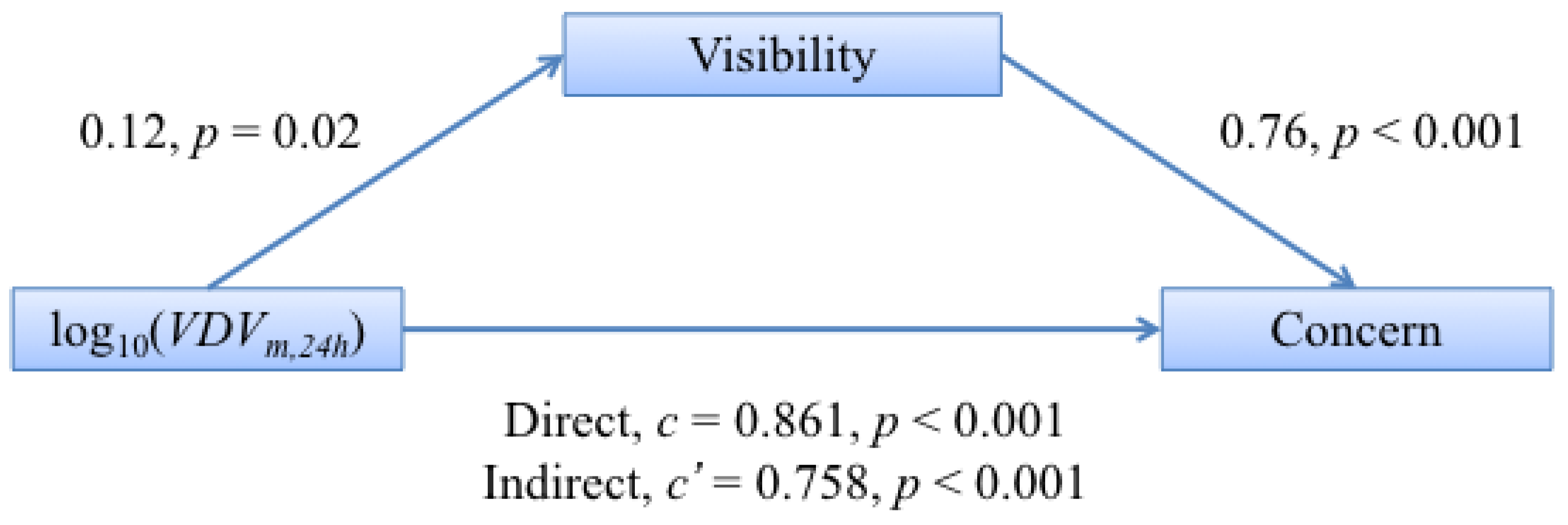
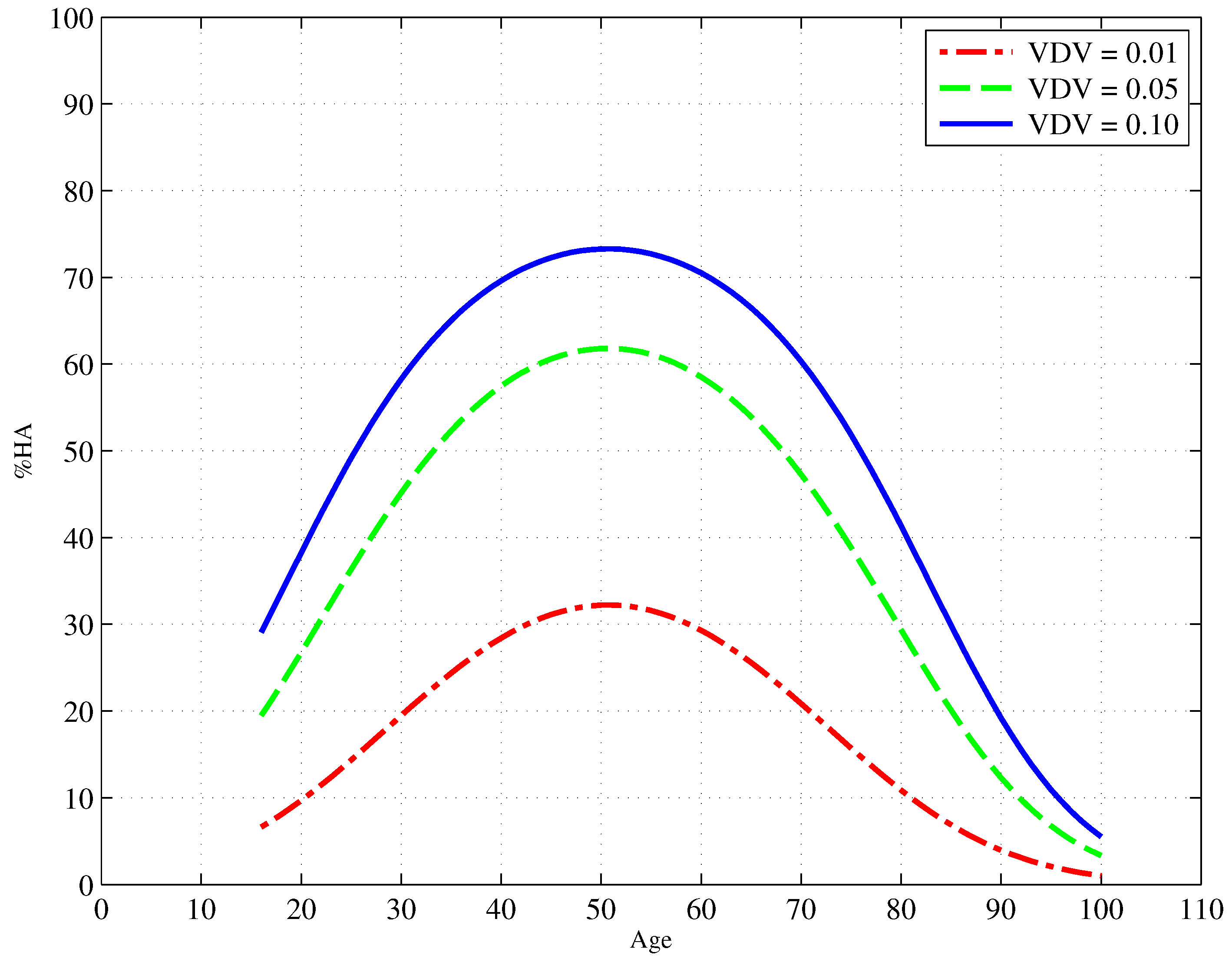

| Age Range | 16–25 | 26–35 | 36–45 | 46–55 | 56–65 | 66–75 | 76–85 | >85 |
| Frequency | 36 | 59 | 68 | 50 | 48 | 37 | 18 | 2 |
| Parameter | Estimates | |||
|---|---|---|---|---|
| Estimates | SE | 95% CI | ||
| Lower | Upper | |||
| Threshold (τ) | ||||
| Not at all | −3.153 | 0.477 | −4.088 | −2.218 |
| Slightly | −2.731 | 0.469 | −3.649 | −1.812 |
| Moderately | −2.177 | 0.460 | −3.079 | −1.276 |
| Very | −1.599 | 0.456 | −2.493 | −0.704 |
| Location (β) | ||||
| log10 VDVm,24h | 1.771 | 0.254 | 1.273 | 2.269 |
| Parameter Estimates | Estimates | |||
|---|---|---|---|---|
| Estimates | SE | 95% CI | ||
| Lower | Upper | |||
| Threshold (τ) | ||||
| Highly Annoyed | 1.046 * | 0.588 | −0.106 | 2.197 |
| Location () | ||||
| log10 VDVm,24h | 0.908 *** | 0.261 | 0.397 | 1.419 |
| Sensitivity () | 0.845 *** | 0.114 | 0.622 | 1.068 |
| Parameters | Estimates | |||
|---|---|---|---|---|
| Estimates | SE | 95% CI | ||
| Lower | Upper | |||
| Threshold (τ) | ||||
| Highly Annoyed | 1.504 ** | 0.569 | 0.388 | 2.619 |
| Location (β) | ||||
| log10 VDVm,24h | 1.243 *** | 0.270 | 0.713 | 1.773 |
| Concern | 1.032 *** | 0.094 | 0.847 | 1.217 |
| Parameters | Estimates | |||
|---|---|---|---|---|
| Estimates | SE | 95% CI | ||
| Lower | Upper | |||
| Threshold (τ) | ||||
| Highly Annoyed | −1.148 * | 0.503 | −2.134 | −0.163 |
| Location (β) | ||||
| log10 VDVm,24h | 1.213 *** | 0.253 | 0.716 | 1.710 |
| Expectation | 0.567 * | 0.245 | 0.086 | 1.048 |
| (vibrations will worsen) | ||||
| Parameters | Estimates | |||
|---|---|---|---|---|
| Estimates | SE | 95% CI | ||
| Lower | Upper | |||
| Threshold (τ) | ||||
| Highly Annoyed | −2.451 *** | 0.481 | −3.394 | −1.508 |
| Location (β) | ||||
| log10 VDVm,24h | 1.782 *** | 0.263 | 1.267 | 2.297 |
| Rent | −1.000 *** | 0.261 | −1.511 | −0.489 |
| Estimates | ||||
|---|---|---|---|---|
| Parameters | Estimates | SE | 95% CI | |
| Lower | Upper | |||
| Threshold (τ) | ||||
| High Concern | −1.530 ** | 0.457 | −2.426 | −0.635 |
| Location (β) | ||||
| log10 VDVm,24h | 1.340 *** | 0.245 | 0.859 | 1.820 |
| Rent | −1.402 *** | 0.267 | −1.925 | −0.879 |
| Estimates | ||||
|---|---|---|---|---|
| Parameters | Estimates | SE | 95% CI | |
| Lower | Upper | |||
| Threshold (τ) | ||||
| Highly Annoyed | −1.803 *** | 0.453 | −2.692 | −0.915 |
| Location (β) | ||||
| log10 VDVm,24h | 1.546 *** | 0.246 | 1.064 | 2.028 |
| Visibility (not visible) | −1.207 *** | 0.233 | −1.662 | −0.751 |
| Estimates | ||||
|---|---|---|---|---|
| Parameters | Estimates | SE | 95% CI | |
| Lower | Upper | |||
| Threshold (τ) | ||||
| High | −2.174 *** | 0.473 | −3.101 | −1.246 |
| Location (β) | ||||
| log10 VDVm,24h | 1.731 *** | 0.259 | 1.224 | 2.238 |
| 0 h | −0.538 | 0.542 | −1.599 | 0.524 |
| 1–3 h | −0.255 | 0.317 | −0.877 | 0.367 |
| 3–6 h | 0.442 | 0.440 | −0.421 | 1.305 |
| 6–9 h | −0.218 | 0.533 | −1.262 | 0.826 |
| Estimates | ||||
|---|---|---|---|---|
| Parameters | Estimates | SE | 95% CI | |
| Lower | Upper | |||
| Threshold (τ) | ||||
| Highly Annoyed | −0.690 | 0.518 | −1.704 | 0.325 |
| Location (β) | ||||
| log10 VDVm,24h | 1.663 *** | 0.256 | 1.161 | 2.165 |
| Neighbourhood Satisfaction | 0.580 *** | 0.098 | 0.389 | 0.772 |
| Estimates | ||||
|---|---|---|---|---|
| Parameters | Estimates | SE | 95% CI | |
| Lower | Upper | |||
| Threshold (τ) | ||||
| Highly Annoyed | −1.441 ** | 0.502 | −2.424 | −0.457 |
| Location (β) | ||||
| log10 VDVm,24h | 1.794 *** | 0.257 | 1.292 | 2.297 |
| Home Satisfaction | 0.408 *** | 0.114 | 0.185 | 0.630 |
| Estimates | ||||
|---|---|---|---|---|
| Parameters | Estimates | SE | 95% CI | |
| Lower | Upper | |||
| Threshold (τ) | ||||
| Highly Annoyed | 1.298 | 0.978 | −0.619 | 3.215 |
| Location (β) | ||||
| log10 VDVm,24h | 1.753 *** | 0.269 | 1.225 | 2.281 |
| Age/100 | −16.027 *** | 4.090 | −24.043 | −8.011 |
| (Age/100)2 | 15.815 *** | 4.064 | 7.850 | 23.780 |
| Estimates | ||||
|---|---|---|---|---|
| Parameters | Estimates | SE | 95% CI | |
| Lower | Upper | |||
| Threshold (τ) | ||||
| High | −1.782 *** | 0.475 | −2.712 | −0.852 |
| Location (β) | ||||
| log10 VDVm,24h | 1.801 *** | 0.256 | 1.299 | 2.304 |
| Male | −0.356 | 0.232 | −0.811 | 0.099 |
© 2016 by the authors; licensee MDPI, Basel, Switzerland. This article is an open access article distributed under the terms and conditions of the Creative Commons Attribution (CC-BY) license (http://creativecommons.org/licenses/by/4.0/).
Share and Cite
Wong-McSweeney, D.; Woodcock, J.; Waddington, D.; Peris, E.; Koziel, Z.; Moorhouse, A.; Redel-Macías, M.D. Effect of Attitudinal, Situational and Demographic Factors on Annoyance Due to Environmental Vibration and Noise from Construction of a Light Rapid Transit System. Int. J. Environ. Res. Public Health 2016, 13, 1237. https://doi.org/10.3390/ijerph13121237
Wong-McSweeney D, Woodcock J, Waddington D, Peris E, Koziel Z, Moorhouse A, Redel-Macías MD. Effect of Attitudinal, Situational and Demographic Factors on Annoyance Due to Environmental Vibration and Noise from Construction of a Light Rapid Transit System. International Journal of Environmental Research and Public Health. 2016; 13(12):1237. https://doi.org/10.3390/ijerph13121237
Chicago/Turabian StyleWong-McSweeney, Daniel, James Woodcock, David Waddington, Eulalia Peris, Zbigniew Koziel, Andy Moorhouse, and María Dolores Redel-Macías. 2016. "Effect of Attitudinal, Situational and Demographic Factors on Annoyance Due to Environmental Vibration and Noise from Construction of a Light Rapid Transit System" International Journal of Environmental Research and Public Health 13, no. 12: 1237. https://doi.org/10.3390/ijerph13121237






